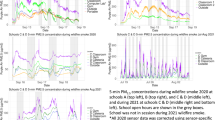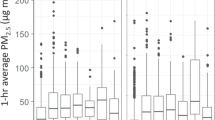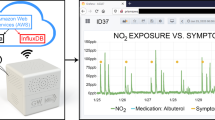Abstract
Community health studies of traffic-related air pollution have been hampered by the cost and participant burden associated with collecting household-level exposure data. The current study utilized a participant-based approach to collect indoor and outdoor air monitoring data from 92 asthmatic and nonasthmatic children (9–13 years old) enrolled in two concurrent health studies in Detroit, Michigan (Mechanistic Indicators of Childhood Asthma and Detroit Children's Health Study) conducted by the US Environmental Protection Agency (EPA). Passive samplers were shipped to participating households and deployed by parents of study participants to collect indoor and outdoor measurements of nitrogen dioxide (NO2), volatile organic compounds (VOCs), and polycyclic aromatic hydrocarbons (PAHs) including naphthalene. Half of the households deployed VOC and NO2 samplers for 7 days; the other half deployed PAH and NO2 samplers for 2 days and additional PAH samplers for 1 day. Approximately 88% of the households that received air sampling kits completed the air monitoring. Compliance was significantly higher among participants asked to deploy all samplers for 7 days (85%) compared with participants asked to deploy some samplers for 2 days and others for 1 day (56%). The 7-day homes were also more likely to provide usable data (96%) compared with the 1- and 2-day homes (73%). Compliance and providing usable data did not vary between parents of asthmatic versus nonasthmatic study participants and were not reduced among households deploying duplicate samplers. These results suggest that participant-based sampling may be a feasible and cost-effective alternative to traditional exposure assessment approaches that can be applied in future epidemiological and community-based health studies.
This is a preview of subscription content, access via your institution
Access options
Subscribe to this journal
Receive 6 print issues and online access
$259.00 per year
only $43.17 per issue
Buy this article
- Purchase on Springer Link
- Instant access to full article PDF
Prices may be subject to local taxes which are calculated during checkout



Similar content being viewed by others
References
Boothe V., Dimmick W.F., and Talbot T.O. Relating air quality to environmental public health tracking data. In: Aral M.M., Brebbia C.A., Maslia M.L., Sinks T. (Eds.). Environmental Exposure and Health. Wessex Institute Transactions on Ecology and the Environment: Southampton, UK, 2005 85, pp 43–52.
Brauer M., Hoek G., Van Vliet P., Meliefste K., Fischer P.H., Wijga A., Koopman L.P., Neijens H.J., Gerritsen J., Kerkhof M., Heinrich J., Bellander T., and Brunekreef B. Air pollution from traffic and the development of respiratory infections and asthmatic and allergic symptoms in children. Am J Respir Crit Care Med 2002: 166 (8): 1092–1098.
Breysse P.N., Buckley T.J., Williams D., Beck C.M., Jo S.J., Merriman B., Kanchanaraksa S., Swartz L.J., Callahan K.A., Butz A.M., Rand C.S., Diette G.B., Krishnan J.A., Moseley A.M., Curtin-Brosnan J., Durkin N.B., and Eggleston P.A. Indoor exposures to air pollutants and allergens in the homes of asthmatic children in inner-city Baltimore. Environ Res 2005: 98 (2): 167–176.
Byrd R.S., and Joad J.P. Urban asthma. Curr Opin Pulm Med 2006: 12 (1): 68–74.
Diaz-Sanchez D., Proietti L., and Polosa R. Diesel fumes and the rising prevalence of atopy: an urban legend? Curr Allergy Asthma Rep 2003: 3 (2): 146–152.
Diette G.B., Hansel N.N., Buckley T.J., Curtin-Brosnan J., Eggleston P.A., Matsui E.C., McCormack M.C., Williams D.L., and Breysse P.N. Home indoor pollutant exposures among inner-city children with and without asthma. Environ Health Perspect 2007: 115 (11): 1665–1669.
Finkelstein M.M., Jerrett M., and Sears M.R. Traffic air pollution and mortality rate advancement periods. Am J Epidemiol 2004: 160 (2): 173–177.
Heinrich J., and Wichmann H.E. Traffic related pollutants in Europe and their effect on allergic disease. Curr Opin Allergy Clin Immunol 2004: 4 (5): 341–348.
Isakov V., Graham S., Burke J., and Özkaynak H. Linking air quality and exposure models. Air Waste Manage Assoc Environ Manager 2006 September 26–29.
Isakov V., and Özkaynak H. A modeling methodology to support evaluation of public health impacts of air pollution reduction programs. Proceedings of the 29th International Technical Meeting on Air Pollution Modeling, Aveiro, Portugal, Sept 24–28, 2007.
Janssen N.A., Brunekreef B., van Vliet P., Aarts F., Meliefste K., Harssema H., and Fischer P. The relationship between air pollution from heavy traffic and allergic sensitization, bronchial hyperresponsiveness, and respiratory symptoms in Dutch schoolchildren. Environ Health Perspect 2003: 111 (12): 1512–1518.
Jerrett M., Arain A., Kanaroglou P., Beckerman B., Potoglou D., Sahsuvaroglu T., Morrison J., and Giovis C. A review and evaluation of intraurban air pollution exposure models. J Expo Sci Environ Epidemiol 2005: 15 (2): 185–204.
Lewis S.A., Antoniak M., Venn A.J., Davies L., Goodwin A., Salfield N., Britton J., and Fogarty A.W. Secondhand smoke, dietary fruit intake, road traffic exposures, and the prevalence of asthma: a cross-sectional study in young children. Am J Epidemiol 2005: 161 (5): 406–411.
McConnell R.B., Berhane K., Yao L., Jerrett M., Lurmann F., Gilliland F., Kuenzli N., Gauderman J., Avol E., Thomas D., and Peters J. Traffic, susceptibility, and childhood asthma. Environ Health Perspect 2006: 114 (5): 766–772.
Nafstad P., Haheim L.L., Wisloff T., Gram F., Oftedal B., Holme I., Hjermann I., and Leren P. Urban air pollution and mortality in a cohort of Norwegian men. Environ Health Perspect 2004: 112 (5): 610–615.
Nicolai T., Carr D., Weiland S.K., Duhme H., von Ehrenstein O., Wagner C., and von Mutius E. Urban traffic and pollutant exposure related to respiratory outcomes and atopy in a large sample of children. Eur Respir J 2003: 21 (6): 956–963.
Özkaynak H., Palma T., Touma J.S., and Thurman J. Modeling population exposures to outdoor sources of hazardous air pollutants. J Expo Sci Environ Epidemiol 2008: 18 (1): 45–48.
Pellizzari E., Lioy P., Quackenboss J., Whitmore R., Clayton A., Freeman N., Waldman J., Thomas K., Rodes C., and Wilcosky T. Population-based exposure measurements in EPA region 5: a phase I field study in support of the national human exposure assessment survey, 1995: 5 (3): 327–358.
Petreas M., Liu K., Chang B., Hayward S.B., and Sexton K. A survey of nitrogen dioxide levels measured inside mobile homes. JAPCA 1988: 38 (5): 647–651.
Rench J.D., Raymer J.H., Thalji L., Spruill M., Salmons C.A., Michael L.C., Pecha M.J., Dean E., and Akland G. Demonstration of low cost, low burden, exposure monitoring strategies for use in longitudinal cohort studies. EPA Report 2004 600/R-04/109.
Ritz B., Yu F., Chapa G., and Fruin S. Effect of air pollution on preterm birth among children born in Southern California between 1989 and 1993. Epidemiology 2000: 11 (5): 502–511.
Ritz B., Yu F., Fruin S., Chapa G., Shaw G.M., and Harris J.A. Ambient air pollution and risk of birth defects in Southern California. Am J Epidemiol 2002: 155 (1): 17–25.
Ross Z., English P.B., Scalf R., Gunier R., Smorodinsky S., Wall S., and Jerrett M. Nitrogen dioxide prediction in Southern California using land use regression modeling: potential for environmental health analyses. J Expo Sci Environ Epidemiol 2006: 16 (2): 106–114.
Ryan P.H., LeMasters G., Biagini J., Bernstein D., Grinshpun S.A., Shukla R., Wilson K., Villareal M., Burkle J., and Lockey J. Is it traffic type, volume, or distance? Wheezing in infants living near truck and bus traffic. J Allergy Clin Immunol 2005: 116 (2): 279–284.
Sarnat J.A., and Holguin F. Asthma and air quality. Curr Opin Pulm Med 2007: 13 (1): 63–66.
Sexton K., Liu K., and Petreas M.X. Formaldehyde concentrations inside private residences: a mail-out approach to indoor air monitoring. JAPCA 1986: 36 (6): 698–704.
Smith L.A., Mukerjee S., Gonzales M., Stallings C., Neas L.M., Norris G., and Özkaynak H. Use of GIS and ancillary variables to predict volatile organic compound and nitrogen dioxide pollutant levels at unmonitored locations. Atmos Environ 2006: 40 (2006): 3773–3787.
Spengler J.D., Duffy C.P., Letz R., Tibbitts T.W., and Ferris B.G. Nitrogen dioxide inside and outside 137 homes and implications for ambient air quality standards and health effects research. Environ Sci Technol 1983: 17: 164–168.
Venn A., Yemaneberhan H., Lewis S., Parry E., and Britton J. Proximity of the home to roads and the risk of wheeze in an Ethiopian population. Occup Environ Med 2005: 62 (6): 376–380.
Whitmore R.W., Byron M.Z., Clayton C.A., Thomas K.W., Zelon H.S., Pellizzari E.D., Lioy P.J., and Quackenboss J.J. Sampling design, response rates, and analysis weights for the National Human Exposure Assessment Survey (NHEXAS) in EPA region 5. J Expo Sci Environ Epidemiol 1999: 9 (5): 369–380.
Wilhelm M., and Ritz B. Residential proximity to traffic and adverse birth outcomes in Los Angeles county, California, 1994–1996. Environ Health Perspect 2003: 111 (2): 207–216.
Williams R. EPA Research Highlights: Detroit Exposure and Aerosol Research Study (DEARS). Air Waste Manage Assoc Environ Manag 2005 October, p 53.
Williams R., and Wheeler A. The DEARS and the WOEAS. Why studies like these are so important to exposure science. Exploring Innovative Approaches in Exposure Science. Proceedings of the 17th Annual Conference of the International Society of Exposure Analysis, Research Triangle Park, North Carolina, October 14–18, 2007:122.
Acknowledgements
We are grateful to willingness and the diligent efforts of all of the study participants who contributed tremendously to the success of this project. We recognize and greatly appreciate the contributions to this study by Dr. Zhihua Fan and Lin Lin at EOHSI with the preparation and analysis of the passive PAH samplers; Dr. Mike Wolfson and Denise Lamoureux at the Harvard School of Public Health with the preparation and analysis of the NO2 badges; and Larissa Altshul, Brian La Brecque and Jose Valero at the Harvard School of Public Health with the preparation and analyses of the VOC diffusion tubes. We are deeply indebted to James Quackenboss and Kent Thomas at EPA/NERL for their detailed and insightful feedback on draft versions of this manuscript. We also thank colleagues at EPA/NHEERL Pauline Mendola, Ann Williams, Chris Garlington, Elizabeth Sams, Kristen Rappazzo, Peter Stone, Kay Williams, Scott Rhoney, Brooke Heidenfelder, Danelle Lobdell, Sharon Myers, Jeff Inmon, Walter Breyer, as well as Daniel Vallero at EPA/NERL and the EPA/NERL machine shop for their support and assistance during this project.
Author information
Authors and Affiliations
Corresponding author
Additional information
Although this work was peer-reviewed by EPA and approved for publication, it may not necessarily reflect official agency policy. Mention of trade names or commercial products does not constitute endorsement or recommendation for use.
Supplementary Information accompanies the paper on the Journal of Exposure Science and Environmental Epidemiology website (http://www.nature.com/jes)
Supplementary information
Rights and permissions
About this article
Cite this article
Johnson, M., Hudgens, E., Williams, R. et al. A participant-based approach to indoor/outdoor air monitoring in community health studies. J Expo Sci Environ Epidemiol 19, 492–501 (2009). https://doi.org/10.1038/jes.2008.39
Received:
Accepted:
Published:
Issue Date:
DOI: https://doi.org/10.1038/jes.2008.39



